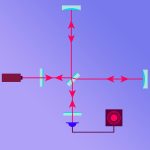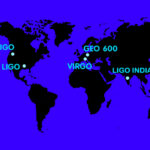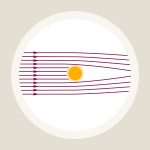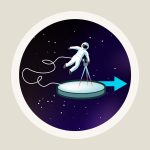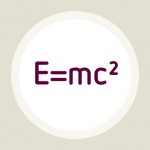Small vibrations
Some information on how the vintage models among gravitational wave detectors work – resonant detectors
An article by Peter Aufmuth
A gravitational wave passing through a solid body, say, through a solid metal cylinder, acts on that body’s atoms as a kind of time-dependent tidal force. This force rhythmically squeezes the body in one direction while stretching it in an orthogonal direction (compare the deformations of the mandala on the page The rhythm of geometry in the chapter Gravitational waves of Elementary Einstein). These rhythmic squeezes and stretches can induce harmonic oscillations of the body in question – especially if that body is predisposed to the particular type of oscillation that gravitational waves are wont to excite (i.e if the body “resonates”).
One possible method for detecting gravitational waves is to detect the ways they influence a solid body’s oscillation. The corresponding detectors are called resonant detectors. They are sensitive to signals with frequencies that are close to the natural oscillating frequency of the detector body, the resonator. This natural frequency basically depends on its mass.
Oscillating metal cylinders
The first gravitational wave detectors were of this type. They were constructed by the US physicist Joseph Weber (1919 – 2000) in the 1960s at the University of Maryland. Weber’s resonant antennas were aluminum cylinders with a mass of 1.5 tons. Suitable gravitational waves would excite the so-called “fundamental longitudinal mode” of the cylinder, whose natural frequency (“eigen frequency”) was around 1600 Hertz. This oscillation deforms the cylinder in the way shown in the following animation (where the extent of the deformation has been greatly exaggerated for clarity):
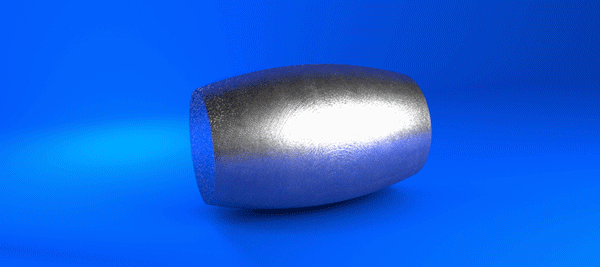
In a frequency range around 1000 Hertz, astrophysicists mainly expect very short pulses of gravitational waves from supernovae – gigantic explosions of massive stars. Such gravitational wave pulses strike a resonant detector like a clapper strikes a bell, and just like a bell, the detector continues to resonate for a bit – this is what makes detection possible. In Weber’s original setup, the cylinder’s deformations were meant to be detected with the help of so-called piezoelectric crystals bonded to the surface of the cylinder: when they are deformed, such crystals produce electrical voltages that can be read out.
Signal and noise
However, Weber’s cylindrical antennas were not nearly sensitive enough to have a chance of detecting gravitational waves. For them, the noise was much too great – for instance, the continual tiny oscillations of the antenna atoms (their thermal motion, used to define the antenna’s temperature) already excites the longitudinal oscillation a hundred times stronger than any gravitational wave would. For this reason, the successor models to Weber’s cylinders, the modern resonant detectors, are cooled down to work at temperatures near absolute zero. The following image shows one of these modern detectors, the NAUTILUS detector in Frascati (Italy), opened for inspection. In the centre, one can see the cylindrical test mass; most of the layers surrounding it serve as thermal insulation:

© 2002 ROG Nautilus
Another problem is the noise of the electrical transducers and amplifiers used to process the gravitational wave signal. For this reason, modern detectors do not use piezo crystals; instead, they use cavity resonators or coils whose electric properties are changed by the deformation of the test mass. To amplify the signal with as little noise as possible, they use so-called SQUIDs, “superconducting quantum interference devices” in which quantum effects are used for amplification. In addition, it is important to suspend the whole test mass as a pendulum, in order to isolate it as well as possible from seismic and other external disturbances. With the help of all these tricks, modern resonant detectors indeed reach the sensitivity needed to detect gravitational waves, as they are able to detect deformations of 10-19 metres.
A brief survey of modern resonant antennas can be found at the end of the spotlight topic Listening posts around the globe. Almost all of them use cylindrical test masses; however, recently a spherical resonator has begun measurements, the Dutch detector MiniGRAIL. In contrast with cylinders, spherical antenna are equally sensitive to all gravitational waves, regardless of the direction they come from. In addition, they can simultaneously measure the wave’s influence on more than one mode of oscillation, which allows the researchers to determine the position of the gravitational wave source in the sky.
Further Information
For background information on gravitational waves, check out Elementary Einstein, particularly the chapter Gravitational waves.
Related Spotlight topics on Einstein-Online can be found in the section Gravitational waves.
Colophon
is a scientist at the Albert Einstein Institute in Hannover who is involved in the maintenance and development of the gravitational wave detector GEO600.
Citation
Cite this article as:
Peter Aufmuth, “Small vibrations” in: Einstein Online Band 04 (2010), 01-1017



